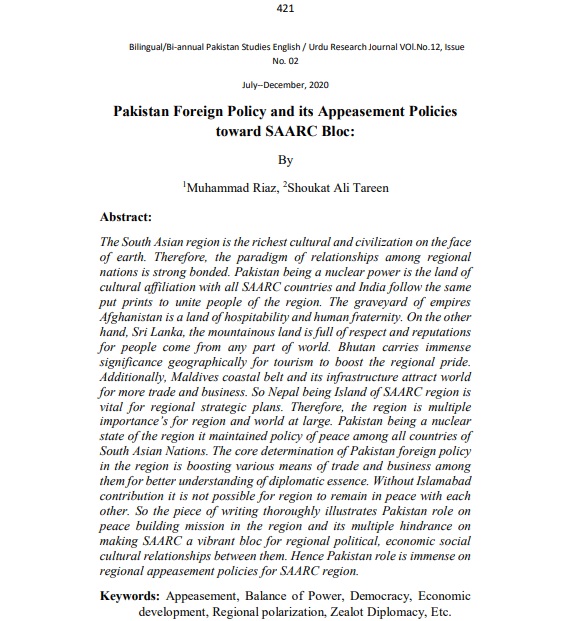Pakistan Foreign Policy and its Appeasement Policies toward SAARC Bloc:
Keywords:
Appeasement, Balance of Power, Democracy, Economic development, Regional polarization, Zealot Diplomacy, Etc.Abstract
Abstract:
The South Asian region is the richest cultural and civilization on the face
of earth. Therefore, the paradigm of relationships among regional
nations is strong bonded. Pakistan being a nuclear power is the land of
cultural affiliation with all SAARC countries and India follow the same
put prints to unite people of the region. The graveyard of empires
Afghanistan is a land of hospitability and human fraternity. On the other
hand, Sri Lanka, the mountainous land is full of respect and reputations
for people come from any part of world. Bhutan carries immense
significance geographically for tourism to boost the regional pride.
Additionally, Maldives coastal belt and its infrastructure attract world
for more trade and business. So Nepal being Island of SAARC region is
vital for regional strategic plans. Therefore, the region is multiple
importance’s for region and world at large. Pakistan being a nuclear
state of the region it maintained policy of peace among all countries of
South Asian Nations. The core determination of Pakistan foreign policy
in the region is boosting various means of trade and business among
them for better understanding of diplomatic essence. Without Islamabad
contribution it is not possible for region to remain in peace with each
other. So the piece of writing thoroughly illustrates Pakistan role on
peace building mission in the region and its multiple hindrance on
making SAARC a vibrant bloc for regional political, economic social
cultural relationships between them. Hence Pakistan role is immense on
regional appeasement policies for SAARC region
References
References:
Ahmed, K. R. (2015). Impediments to the success of SAARC . South
Asian Studies , 09.
Emma, H. (2018). Pakistan future scenarios and regional context.
CIDOB , 12-13.
Jerry, S. M. (2009). Sturdy dominons the national interests .
Nationalinterests.com , 13.
Kanan, K. (2018). Looking Southasia: SAARC and international trade
disruption . London Institute of economics and political science
, 22-27.
Kathaleen, M. M. (2009). State violence and right to peace . ABC CLIO
, 04-06.
Maham, H. (2018). The politics of thr China-Pakistan economic corridor
. Palgraee , 09-12.
Mansoor, K. A. (2005). Pakistan post 9/11 foreign policy challenges and
responses. Quetta: Quetta Press.
Meena, R. S. (2006). Pakistan strategic in Central Asia. Institute for
defence studies and analysis Dehli , 12.
https://www.orfonline.org/expert-speak/india-pakistan-tension-isthere-role-for-saarc-48690/
Narveeda Yousaf, Mansoor Ahmed and Zahir Shah. (2017). SAARC
summit and Pakistan foreign policy. An analysis . Journal of the
research of Pakistan Peshawar , 13-17.
Peak, C. (1998). Sustainable peace the role of UN and regional
organization. London: Carnage Cooperation.
Pervez, C. I. (1998). The crisis and Pakistan security dilemma . Asian
survey , 18.
Rashid, A. (2012). Pakistan and Afghanistan and US withdrawal. Royal
institute of International affairs , 11-18.
https://www.quora.com/What-is-the-role-of-Pakistan-in-SAARC432
Shabaz, T. (2018). Pakistan Geo strategic significance . Daily Times ,
Shamil, S. (2016). Greater SAARC and Pakistan regional isolation.
Dw.com , 22-28.
Sikri, R. (2007). India foreign policy priorities and regional context.
ISAS , 29-33.
Touqir, H. (2010). US-Pak relations what trust deficits? The Middle East
Institute , 15.
Zahid, A. S. (2008). SAARC and interstste conflict in South Asia:
Prospects and challenges for regionalism. Pakistan horizon , 11-
Zahid, S. (2010). Understanding Pakistan relations with Iran. Middle
East Policy , 14-18.
https://www.pakistantoday.com.pk/2011/11/15/the-role-of-saarc/



